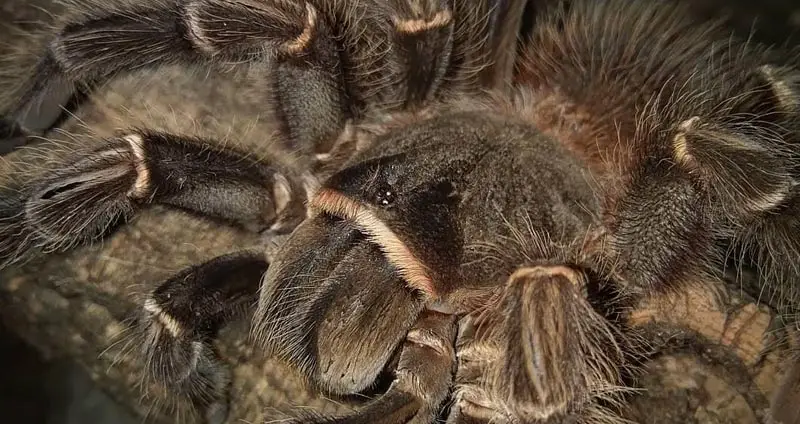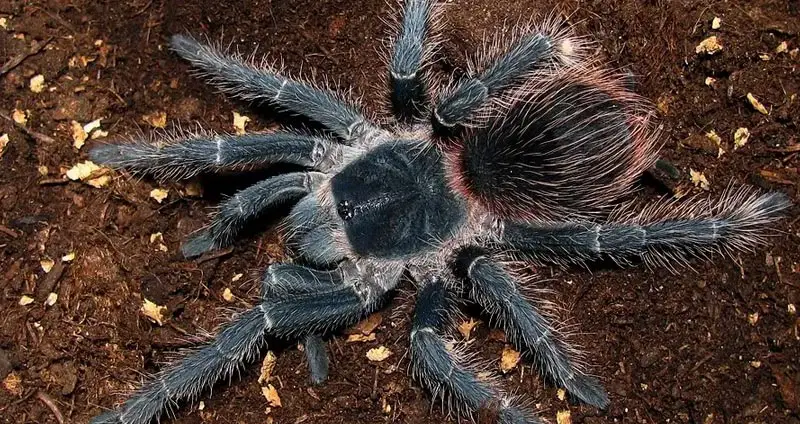With so many tarantulas in existence, there’s bound to be a “perfect” tarantula species for everybody. Some people prefer tarantulas that are laid-back and can easily be held, while others prefer tarantulas that never leave their burrows. If you’re looking for a great tarantula that’s full of spunk and has a personality even bigger than themselves, Lasiodora klugi may be perfect for you. You’ll be hard-pressed to find a tarantula that’s more of a full package than this species.
If you’re looking to add one of these tarantulas to your collection soon, there are a few things that you should be aware of. This post will cover Lasiodora klugi‘s awesome appearance, fun personality, and all of their environmental and dietary needs.
Table of Contents
Lasiodora klugi Care Sheet
| | |
Common Name |
Bahia Scarlet |
Species Type |
New world terrestrial |
Natural Habitat |
Found in Brazil, specifically the state of Bahia. The climate is consistently quite warm, with summer months experiencing substantial rainfall. |
Growth Rate |
Medium-to-fast growth rate. Females and males grow slightly faster than many other species. |
Adult Size |
Females reach a legspan of between 7″ and 8″, with males measuring slightly smaller. |
Lifespan |
Females regularly live between 15 and 20 years, while males often only live to 4 years. |
Enclosure |
The enclosure needs to be much wider than it is tall. Several inches of substrate should be provided for burrowing, in addition to rocks, sticks, and fake plants to attach webbing to. A hide and water bowl should also be provided. |
Temp/Humidity |
75°F to 80°F with about 65% to 75% humidity. |
Diet |
Good eater that can eat several adult-sized crickets per week. Dubia roaches and mealworms should be used as supplemental food. |
Temperament |
Is more skittish than defensive/aggressive. Will flick particularly nasty hairs when threatened, though. |
Experience Level |
Beginner – Quite an easy tarantula to care for. Agreeable temperament and environmental needs that are easy to meet. |
Average Cost |
Slings ~ $30, Males ~ $75, Females ~ $125+ |
Lasiodora klugi Appearance
One thing to note about this species is that it doesn’t have a very unique appearance, but that doesn’t mean it isn’t stunning to look at. It has a relatively uniform black coloring throughout its entire body, which is broken up by white-ish accents especially around the legs. One great characteristic is the fact that its abdomen features dark red hairs that never fail to draw the eye.
This is an appearance that’s grown into, though. As spiderlings, this species takes on a dark gray color with white hairs throughout its body. As it matures into a juvenile, it darkens in color, gains the white accents, and starts developing the red hairs.
When it comes to sizing, these tarantulas grow to be quite big creatures! Adult specimens can easily reach 8″+ in legspan, reaching this size in a relatively short amount of time. This big size helps to amplify their lively personalities, really making them one of the more interesting tarantula species.


via @eight_eyed_legion / Instagram
Lasiodora klugi Temperament
The temperament of these tarantulas is what makes them so appealing to many people. They’re in a kind of no man’s land where they exhibit the traits of several different tarantulas — something that’s not commonly done! Fortunately, most of those traits simply come together to create a very interesting species that’s beloved by beginners and experienced keepers alike.
Lasiodora klugi are new world tarantulas, which are tarantulas that are known for being laid-back and prefer to run from danger rather than fighting it. Typically, new world tarantulas are recommended for beginner keepers due to these traits. While this species is no exception to that definition, they do differ from other new world tarantulas in many ways.
To begin with, these tarantulas can be described as bold. They sometimes will assume a defensive stance, but they definitely prefer to flee than stand their ground. As new world tarantulas, they have a defensive mechanism called urticating hairs, which are barbed hairs that they can flick at potential threats. Bahia Scarlets flick hairs more frequently than most other species, making them a lot of fun to observe (and a bit dangerous, too).
One more thing to note about this species is that it absolutely loves food. This is one of the most aggressive eaters you’ll find, happily eating anything that’s put in their way. They’re known to never refuse a meal unless they’re nearing a molt, so this can result in some plump abdomens and generally huge specimens.
The fact that they happily eat anything goes hand-in-hand with the fact that the entire Lasiodora genus is extremely easy to care for. They’re very hardy creatures that don’t have many specific needs, and they’ll gladly hang around in the open for you to observe them during the day. This makes them excellent for both beginner and experienced tarantula keepers.
Housing Lasiodora klugi
If you want to take home a Lasiodora klugi for yourself, you need to make sure that their environmental needs are being met through their enclosure. Fortunately, as stated, this species has extremely modest needs that anybody can meet with just a little bit of effort. They’re hardy, too, meaning that they’re able to survive even if their care is a bit sub-optimal.
First of all, it’s important to note where this tarantula species is from. This species is endemic to Brazil, with its name being a reference to the state of Bahia. The majority of Brazil sees year-round average temperatures exceeding 72°F with a substantial amount of rainfall during the summer months. This is quite similar to the environment of many other tarantulas, making caring for Bahia Scarlets a fairly simple and familiar process.
Optimal Enclosure
Lasiodora klugi don’t have many specific needs when it comes to their enclosure. To begin with, these tarantulas are terrestrial with a need to burrow — especially as spiderlings. Therefore, their enclosure should feature a lot of floor space with plenty of room to burrow and walk around. Additionally, they tend to be decently heavy webbers, so a few anchor points should be present in the enclosure to help them with their web.
A fully-grown adult specimen would be more than comfortable in this Exo Terra 18″x18″x12″ glass terrarium. This particular enclosure is great due to its front-opening door and height that’s tall enough to give you access to the inside while keeping the tarantula from running out. It’s extremely high-quality in terms of construction, too, so it’s a one-time purchase that will last for many years.
The inside of the terrarium can be very simple but should be as burrow-friendly as possible. This primarily entails layering about 5 inches of substrate on the bottom that can be dug into. The substrate can be kept decently dry, only being moistened through an occasional spray of water or deliberate overfilling of a small water bowl.
Other than those two factors, there isn’t much else that needs to be added. A piece of cork bark for a hide and some fake plants for decoration may be added, but they aren’t essential.
Heating The Enclosure
In the wild, Lasiodora klugi experiences a consistently warm climate with average humidity. To match the climate of their habitat in Brazil, you should keep the enclosure right around 78°F. Room temperature is typically suitable, but supplemental heating may be necessary in colder climates.
In order to keep one part of the enclosure warm enough, you’ll need to provide supplemental heating. A gentle heat lamp can be turned on and off as needed, or a space heater can be used to warm up the entire room that the tarantula enclosure is in.
While some regions of Brazil can be quite humid, Bahia Scarlets thrive in enclosures with average humidity levels. Most owners maintain a steady 70% humidity in their enclosures. This can be maintained by observing the humidity with a simple hygrometer and spraying the substrate with water when the humidity drops too low.
Lasiodora klugi Diet
The Bahia Scarlet tarantula grows into a very large tarantula very quickly, but only if their nutritional needs are being met. Fortunately, as stated previously, those needs aren’t difficult to meet at all. With such a ravenous appetite, you’ll find that your Lasiodora klugi will eat anything that you put in front of it, even if they’re not very hungry.
As a spiderling, this species will eat fruit flies until they reach about 1/2″ in size. At this point, they can eat baby crickets. As a full-grown adult, they can eat 2 dubia roaches or 10 adult crickets per week, always attacking their food with a vengeance.
It’s important to note that just because these tarantulas can eat a massive amount of food, that doesn’t mean that they should. Some owners have seeing their specimens getting quite plump, forcing them to feed just a bit less than they normally do.
Health Concerns
Captive tarantulas don’t tend to experience many health problems at all. If you supply your Lasiodora klugi with a burrow-friendly enclosure and a diet that satisfies their insatiable hunger, they should live a totally happy and healthy life. The only issues that captive tarantulas run into are typically dehydration and parasites/mites — things that are easily avoided and dealt with.
It’s important to note that this tarantula needs to burrow in order to remain healthy. They have evolved to thrive in an environment with burrows that they can retreat into to sleep or feel more safe. If they can’t burrow, they may exhibit strange or destructive behavior that no owner wants their tarantula to go through.
Additionally, it’s possible that your tarantula may experience a problem with its molt. This is especially important for Lasiodora klugi, which is a fast grower than can undergo several molts in a short time frame.
While most molts happen without a problem, they can sometimes get stuck. If this happens, you’ll need to help your tarantula complete their molt. Fortunately, there are quite a few guides online that tell owners how to best go about helping to remove their tarantula’s exoskeleton.
Lasiodora klugi For Sale & Price
Despite the fact that this tarantula has a lot of redeeming qualities that make it a great addition for any collection, it’s not extremely popular! This may be due to the fact that its appearance isn’t extremely unique and its personality is suitable for someone between a beginner and an advanced keeper. Regardless, this has resulted in Lasiodora klugi selling for a decently low price.
You can typically find a healthy spiderling being sold for around $30 from various online marketplaces and breeders, and this usually includes a good health and safe arrival guarantee. For such a fascinating species, this price is surprisingly low and manageable for most people.
For $30 you’re getting quite a lot of tarantula! Lasiodora klugi have a wonderfully unique appearance and an even more noteworthy personality. Their individuality as a species makes them a favorite among some experienced tarantula keepers and surprises people that haven’t heard of them before. So, if you want a tarantula that absolutely loves to eat and won’t hesitate to flick some hairs if they’re annoyed, the Bahia Scarlet tarantula is perfect for you!


In care sheet: “Rarely flicks hairs (Usually rubs hairs into its webs)”
3rd paragraph under Temperament: “Bahia Scarlets flick hairs more frequently than most other species”
Wow, good catch! Thank you! I copy and paste the “care sheet” into each post to keep the formatting, but I totally forgot to change that line from my Avicularia geroldi care sheet. Fixed 🙂